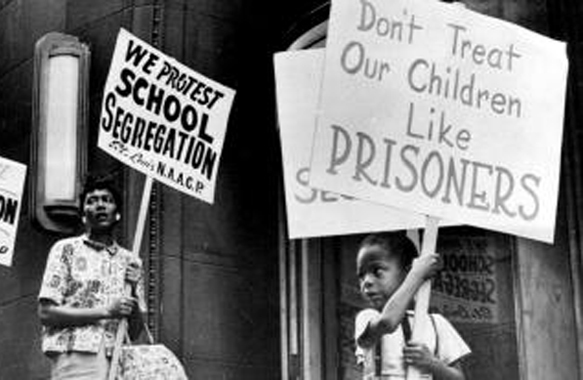
Ferguson’s Schools Are Just as Troubling as Its Police Force
By Tracey Meares | Originally Published at The New Republic. August 22, 2014
A day after his visit to Ferguson, Missouri, Attorney General Eric H. Holder stated in a press conference that, “History simmers beneath the surface in more communities than just Ferguson.” To what history was he referring? Many assumed General Holder meant the longstanding tensions between the mostly black residents of Ferguson and the mostly white police force, but I believe General Holder meant a deeper and broader history that goes well beyond policing. The anger in Ferguson is not just in reaction to shabby treatment by the police, but also the city’s housing, educational, and other civic institutions.
The history of racial mistrust in Ferguson can be found in the legacy of residential segregation in the St. Louis metropolitan area, enforced from the early to the middle twentieth century through mechanisms such as racially restrictive covenants, zoning laws, realtors agreements, and assessors ratings, as research by Professor Colin Gordon demonstrates. Because of these longstanding policies, black Ferguson residents today are disproportionately renters without a strong political stake in the town’s governance and geographically concentrated in areas without economic power.
The broader perspective can be found by looking to recent events surrounding the school district that serves Ferguson residents. Michael Brown graduated from Normandy High School, which was located, until recently, in the Normandy School District. The facts here are a bit complex, but note that I said “until recently.” That is because the Normandy School district lost its accreditation in 2012 due to dismal standardized test scores. (Normandy was one of only three out of 500 school districts in Missouri to lose its accreditation.) The state school board took over the Normandy School District and renamed it the “Normandy School Collaborative.” By 2013, though, the new district also had lost its accreditation. Missouri law allows students of failed districts to transfer to higher-performing schools in surrounding suburbs, but the failing school district has to pay tuition and transportation costs to get the kids to their new schools. The 1,000 transfer students of Normandy obviously had no desire to remain in the “new” failed district, but the cost was high, so, incredibly, the state board voted to waive accreditation of the Collaborative rather than classify the new district as unaccredited. Ferguson’s teenagers were therefore trapped in a failed school because state politicians didn’t want to pay for them to transfer out.empathyeducates – Ferguson’s Schools Are Just as Troubling as Its Police Force:
Study; Police Often Provoke Protest Violence
Photograph; Demonstrators supporting protesters in Ferguson, Mo., hold up mirrors to police during a march Wednesday in Oakland. Photo Credit: Scott Strazzante, The Chronicle Beginning at birth we teach our children. We teach them how to talk, how to walk, and how to act with other children. […]
